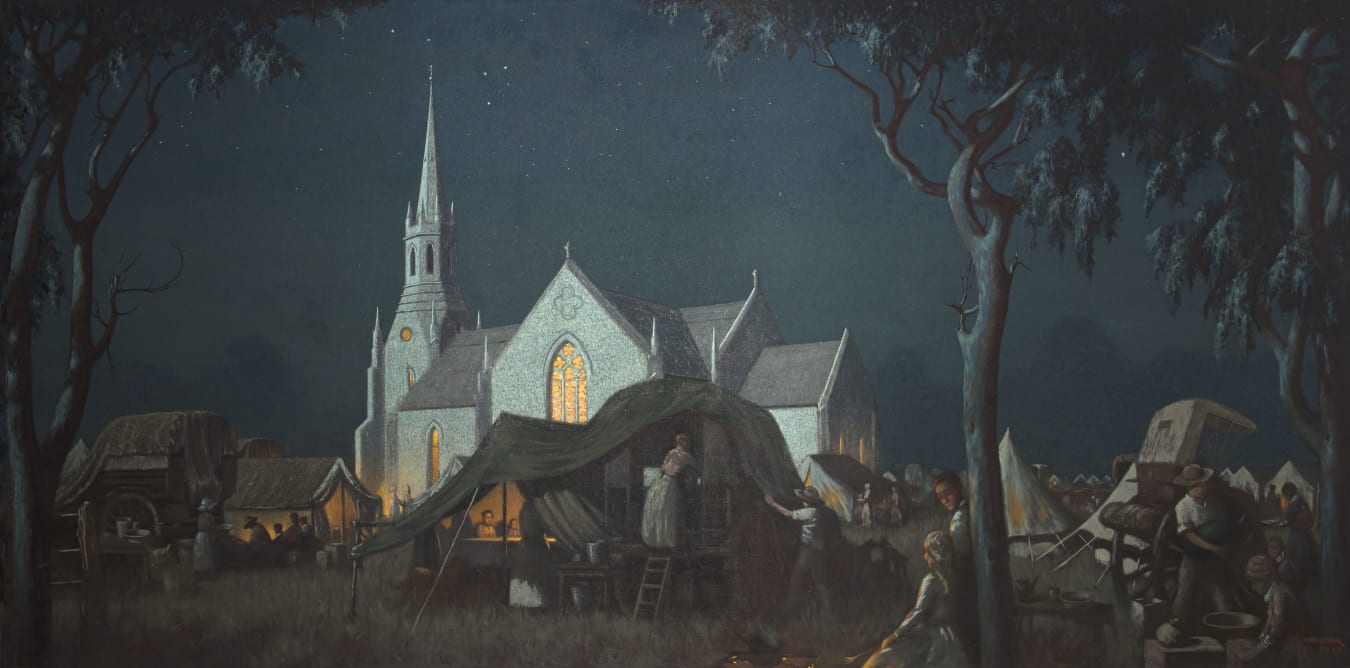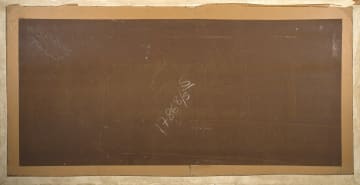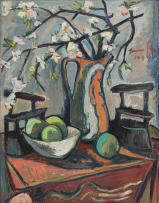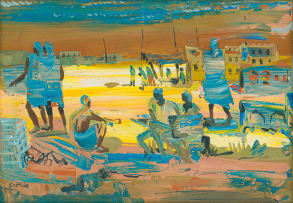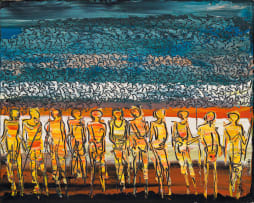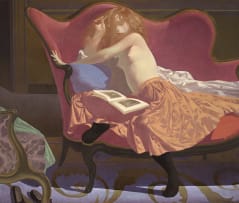Nagmaal, Middelburg
Willem Hermanus Coetzer
Incl. Buyer's Premium & VAT
About this Item
signed and dated 57-60; inscribed with the title on the reverse
Notes
W H Coetzer is best known for his paintings which frame the vistas of the South African landscape in a pleasant pictorial transcript. His landscapes, charmingly mimetic in their rendering of the space and light common to South Africa also included in the distance huts and figures, just visible to the viewer, more as an agent of decoration, rather than deliberate inclusion.
Academic work on Coetzer's artistic production and place within the South African cannon seems to have ground to a halt having reached the conclusion that his work drove a narrative which is the opposite to the modernist aesthetic adopted by his contemporaries. Irma Stern's Umgababa (fig. 1) where the figure of a woman is juxtaposed next to a railway track, a grudging nod by the artist to the reality of modernisation and the changes she witnessed during her decades of travel.
But there are overlaps which need to be examined.
In 1934, Coetzer took rooms at the hotel directly across from the Wit Kerk in Middelburg in the then Transvaal (now Mpumalanga). His interest in historical events particular to South African life before the 1950s, stemmed from his interest in the writings of Gustav Preller. Preller was known for encouraging the idea of collective nationhood through the manner in which he revisited landmark historical events in his writings. Coetzer became familiar with the writings of Preller in 1934: 'For the next thirty years of my life I was to dedicate myselfto honouring the memory of my people, by putting on canvas their tragic and heroic past.'1
Coetzer proceeded to produce various sketches, graphics and paintings of the events he witnessed; the arrival of the wagons, the setting up the camp, the celebrations and events during those few days (fig 4, 5, 6). This includes the work titled, Nagmaal, Middelburg, Transvaal (1934 - in the collection of the Durban Art Gallery (fig. 2).
In Nagmaal, Middelburg (1957-60), a later revisiting on a far grander scale of the earlier series of the same subject, Coetzer depicts the church from a different vantage point, and at night. The sole source of light in this work emanates from the church windows and the interiors of the tents set up in the grounds of the church. Beyond
this light, shadowy figures have been captured going about their tasks; a mother walks with a child strapped to her back, another woman crouches in the lower right corner, discernible by the kopdoek she is wearing. All are on the fringes of the intimacy of the campsite and domestic vignettes.
In his catalogue entry for the exhibition, Revisions+: Expanding the Narrative of South African Art, Hayden Proud remarked that it was an irony, if not a contradiction, that a work by W H Coetzer was included in a collection which sought to address an overlooked chapter in South African art history.2 The work offered here serves as a visual missive. Nagmaal, Middelburg has captured a scene which no longer forms part South Africa's everyday life while bringing together all the romanticism of Afrikaner history.
In the post-Apartheid present, this work poses an interesting hypothesis. The deliberate inclusion of African subjects supports the argument made by Proud that Coetzer was not blinkered to the social inequalities of Apartheid South Africa, and that his form of digestible realism was in fact his way of slipping this narrative onto the walls of ordinary South African homes, subverting the Nationalist rhetoric until it could be examined fresh in the future. The year 1957 was a tumultuous one in South African history. With the Pass laws firmly in place the United Nations appealed to South Africa on 30 January 1957 to repeal its Apartheid policies. The Treason Trial continued, having begun during the first week of December the previous year. The Alexandra Bus Boycott (January to June 1957) was successful in its demands to see the government reinstate its subsidy to the Putco bus service. The Catholic Church of South Africa strongly condemned the structure and aims of Apartheid. Divisions were also experienced within the N G Church, where certain prominent members supported the rhetoric of the other churches - these were quashed in official statements by other senior members of the church. The Revisions work is a complete departure for Coetzer. Undated, the work depicts a scene at sunset in a township. A woman stands over a brazier cooking food, other figures can be seen, dirt roads and rough temporary dwellings - the more things change, the more they stay the same. The snapshot work (fig. 3) in The Campbell Smith Collection (now Homestead Collection), may well have been painted as recently as yesterday.
1. A M Van School (1980) W H Coetzer 80, CUM Books: Roodepoort, unpaginated.
2. Hayden Proud (2008) Revisions+: Expanding the Narrative of South African Art - the Campbell Smith Collection, exhibition catalogue, Stellenbosch: SMAC Art Gallery, page 22.
Provenance
Mr C. Schoeman, Johannesburg.
Stephan Welz & Co in Association with Sotheby's, Johannesburg, 17 May 1999, lot 313.
Exhibited
Rand Afrikaans University, Johannesburg, W.H. Coetzer: Retrospective of Historical Paintings, 1970, cat. no. 57.
View all Willem Hermanus Coetzer lots for sale in this auction
